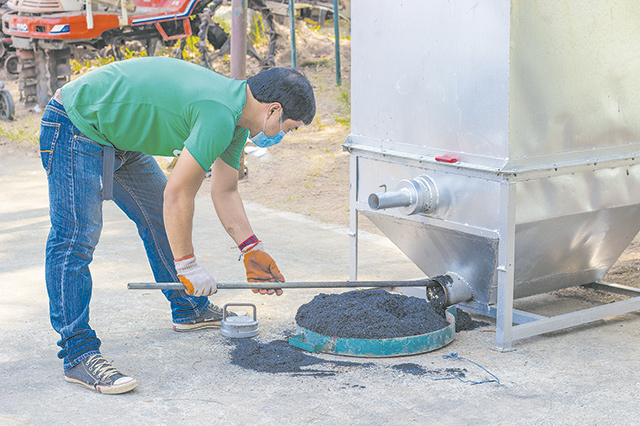
The continuous type rice hull carbonizer (CT-RHC) developed by DA-PhilRice is boosting livelihood opportunities for rice farmers who use the heat from the carbonization process as alternative energy source.
Rice hull is often seen as a mere waste material. But DA-PhilRice experts led by Dr. Ricardo Orge have developed the carbonizer that harnesses rice hull as biomass feedstock.
The carbonizer converts rice hull into biochar. It is used as soil conditioner, nutrient and microbial carrier, remediation agent for toxic materials in organic contaminants, catalyst for industrial applications, and porous material for mitigating greenhouse gas emissions, feed supplements, and odorous compounds.
The carbonization process produces heat, which is an alternative to the expensive and fossil fuel-based liquefied petroleum gas (LPG).
“We are now in the process of commercializing the technology,” according to Orge, Scientist II at our Rice Engineering and Mechanization Division.
This carbonizer is now enabling farmers to grow mushrooms economically and in a much easier and convenient way while processing rice hull into biochar. The heat from the carbonization process is used to pasteurize mushroom fruiting bags. Mushroom production at DA-PhilRice in Nueva Ecija has a batch capacity of 500 fruiting bags.
DA-PhilRice helps farmers’ cooperatives adopt the technology in other income-generating activities. Rice diversification and multi-livelihood engagements for farmers are thrusts of “Palayamanan Plus”.
“My dream is simply for my children to have better jobs and lives. If we were to rely on farming, it will not be enough,” said Daniel Danilo, farmer from Bagong Pagasa sa Bagong Talavera Primary Multipurpose Cooperative in Nueva Ecija.
“With the steel drum that we used before to pasteurize mushroom fruiting bags, we burned wood, which we had to continuously nudge. Burning takes a long time. Now it’s fast, we just push it forward, and the flame is continuous,” he added.
“Using the drum was truly difficult. While it was raining, a roofing sheet should be placed over the firewood. It was such a slow process. With the carbonizer, it’s easy to watch over it. When the fire dies out, I no longer have to go down on my knees and blow on the firewood. Now it’s convenient,” Liwayway Danilo concurred.
While a drum only produces 76 pieces of mushroom fruiting bag per day, the rice hull carbonizer turns out 500 pieces a day. “After one month, it’s already cash!” Liwayway said.
Heat from the carbonizer also works in poultry raising. It keeps the chicks warm during their first two weeks. A poultry raiser in Cuyapo, Nueva Ecija has already tried it. It is also being tried in roasting chicken. The rice hull carbonizer can operate continuously almost without smoke. It contributes to climate change mitigation.
“With appropriately designed attachments and while producing biochar, farmers can use this carbonizer in processing high-value products for additional income,” Orge said.
Aside from rice hull, the machine can also carbonize chopped rice straw, coconut husk, and wood. However, amount of air should be regulated to diminish smoke emission.
“The cooking attachment was primarily developed for entrepreneurs who want to sell cooked products such as boiled green corn, banana, or peanut along the roads,” Orge said.
One housewives’ group in Aurora also tries to use the heat for cooking salted eggs while producing biochar as ingredient of organic fertilizer. Another attachment is a baking/ drying oven.
Other potential uses of the heat are production of essential oils from herbs or medicinal plants, distilled water, and diesel fuel from plastic wastes.
“Because the heat generated by the carbonizer is stable, it is possible that we can use it for household lighting,” the scientist added.




